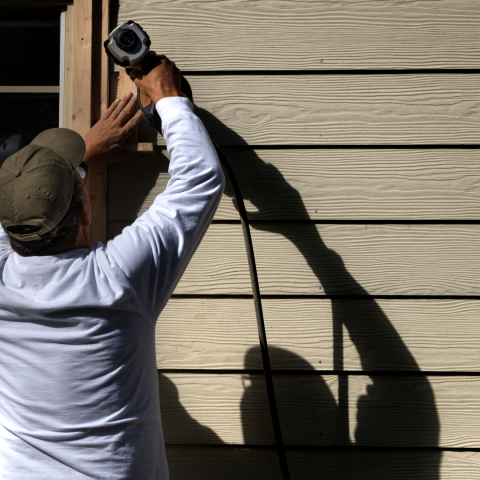When it comes to safeguarding your home from the devastating effects of a wildfire, understanding the role of your homes siding in protecting your roof is crucial. By having a clear understanding of how siding contributes to the overall fire resistance of your property, you can take proactive measures to enhance your home’s defense against wildfires.
Your homes siding serves as the first line of defense against wildfire damage to your roof. Its primary role is to provide a protective barrier, preventing flames, embers, and radiant heat from reaching the vulnerable components of your roof, such as the underlayment and underlying structures.
Understanding the Role of Homes Siding in Wildfire Protection
Wildfires are a growing concern for homeowners living in fire-prone areas. These fires can spread rapidly and pose a significant threat to the roof of your home. However, your homes siding plays a vital role in protecting your roof by acting as a first line of defense.
During a wildfire, flames, embers, and radiant heat can quickly reach vulnerable components of your roof, such as the underlayment and underlying structures, leading to potential ignition and rapid spread of fire. The siding acts as a protective barrier, preventing these fire elements from accessing and damaging your roof.
A case study conducted in a wildfire-affected area showcased the impact of siding on roof survival. Homes with properly installed and fire-resistant siding materials demonstrated a significantly higher chance of roof preservation compared to those with inadequate or non-fire-resistant siding.
Fire-Resistant Siding Materials
Choosing the right siding material is crucial in enhancing the fire resistance of your home. There are several options available, each with its own set of features and benefits:
- Fiber cement siding is renowned for its durability, low maintenance, and excellent fire resistance. Made from a blend of cement, sand, and cellulose fibers, it provides exceptional protection against flames and heat. This type of siding is non-combustible, making it an ideal choice for homeowners in wildfire-prone regions.
- Metal siding, such as steel or aluminum, offers superior fire performance and durability. It is non-combustible and can withstand intense heat. Metal siding also provides an added advantage of being resistant to pests, rot, and moisture, making it a reliable choice for fire protection and long-term durability.
- Traditional wood siding can be made more fire-resistant through various treatment methods. Chemical treatments, such as pressure impregnation with fire-retardant chemicals, can significantly enhance the wood’s ability to withstand fire. Treated wood siding offers the natural beauty of the wood while providing increased protection against wildfires.
A comparative analysis of these siding materials during wildfire incidents revealed that homes with fiber cement and metal siding had a higher probability of withstanding fire and protecting the roof compared to those with untreated wood siding or vinyl siding.
Proper Installation Techniques
The effectiveness of your siding in protecting your roof largely depends on proper installation techniques. Professional installation ensures that the siding is correctly fitted and sealed, leaving no gaps or vulnerabilities that could allow the fire to penetrate.
Sealing joints and gaps between siding panels are essential to prevent the entry of embers and radiant heat. This can be achieved by using fire-resistant caulking or sealants specifically designed for this purpose. Additionally, ensuring adequate clearance between the siding and combustible materials, such as vegetation or flammable debris, further minimizes the risk of ignition.
A case study examining the impact of proper installation techniques on roof safety revealed that homes with professionally installed siding had a significantly higher chance of roof protection during wildfires, emphasizing the importance of expert installation.
Siding Maintenance for Wildfire Protection
Regular inspection and maintenance of your siding are crucial to ensure its effectiveness in wildfire protection. Here are some maintenance practices to consider:
- Conduct routine inspections to identify any signs of damage, such as cracks, warping, or decay. Promptly repair or replace damaged siding to maintain its fire-resistant properties.
- Keep your siding clean and free from debris, as accumulations of leaves, twigs, or other flammable materials can provide fuel for a fire. Regularly remove such materials to minimize the risk of ignition.
A case study examining the impact of maintenance on siding performance during a wildfire revealed that well-maintained siding demonstrated better fire resistance and reduced the risk of roof ignition compared to neglected or poorly maintained siding.
Enhancing Overall Wildfire Resilience
While siding plays a crucial role in protecting your roof, it is essential to adopt a comprehensive approach to enhance overall wildfire resilience. Consider the following measures:
- Create a defensible space around your home by removing flammable vegetation, maintaining proper clearance between trees and structures, and using fire-resistant landscaping materials.
- Incorporate fire-resistant plants and materials in your landscaping design. Use gravel or non-combustible mulch near your home and strategically place fire-resistant shrubs and trees away from the structure.
A case study highlighting the combined impact of siding and landscaping on roof protection during wildfires demonstrated that homes with both fire-resistant siding and well-designed defensible space had a significantly higher chance of surviving wildfires with minimal roof damage.
Additionally, in wildfire-prone areas, insurance requirements and building codes often emphasize the importance of fire-resistant materials, including siding. By investing in fire-resistant siding materials and complying with building codes, homeowners may qualify for insurance benefits and potentially enjoy cost savings.
Can home siding alone protect my roof from a wildfire?
While siding plays a critical role in protecting your roof during a wildfire, it is not the sole factor. Siding acts as a protective barrier, reducing the risk of flames, embers, and radiant heat reaching vulnerable roof components. However, a comprehensive approach that includes fire-resistant materials, proper installation, regular maintenance, and other wildfire mitigation measures, such as defensible space and fire-resistant landscaping, is necessary for optimal roof protection.
Understanding the crucial role of your homes siding in protecting your roof during a wildfire empowers you to take proactive steps to enhance your homes defense against this natural disaster. Contact Just Roofs and Gutters to assist you with finding a siding contractor and schedule a roof inspection.





